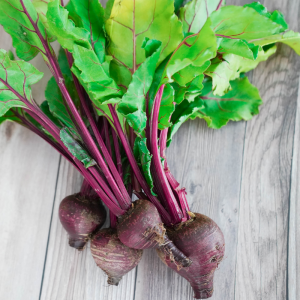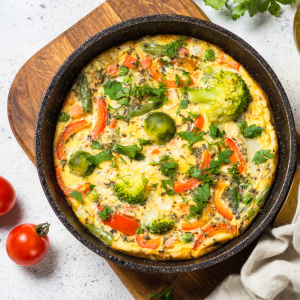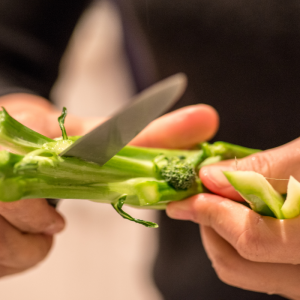 Today I’d like to chat about how to reduce food waste with root-to-top eating and other strategies. I’m riffing, of course, on the carnivorous nose-to-tail concept where you consume as much of an animal as possible in order to reduce waste. Though in this case I am talking about vegetables. Why should we be concerned about food waste? Because:
Today I’d like to chat about how to reduce food waste with root-to-top eating and other strategies. I’m riffing, of course, on the carnivorous nose-to-tail concept where you consume as much of an animal as possible in order to reduce waste. Though in this case I am talking about vegetables. Why should we be concerned about food waste? Because:
- globally, we waste more than one third of our food (in Canada, food waste is estimated at approximately 20%), with food waste responsible for 10% of greenhouse gases and
- the price of food appears to be going nowhere but up.
Canada’s food inflation rate hit 6.5% in January compared with a year earlier. And I read in this recent article that “one in five are buying less fresh fruit and fewer vegetables” as a response to inflation. This saddens me since they are so vital to optimal health.
So I’d like to offer up some suggestions for:
- storing vegetables so they keep well,
- using as much of the vegetable as possible and
- how you can purchase vegetables more economically, including those that would otherwise go to waste.
No one enjoys a limp or slimy vegetable
The best way to ensure you eat lots of vegetables are to keep them in the freshest condition possible until you prepare them. A fresh vegetable is a more nutritious vegetable, certainly. But the vegetable that is the most nutritious is the vegetable you actually eat. And no one enjoys a limp or slimy vegetable. Yuck. I ask my clients to do a photo food journal while we are working together. And when I inquire about a plate where vegetable are MIA, what I usually hear is this: “I bought the green beans [or bok choy, or kale, or broccoli etc.] but when I went to use them they’d gone bad.” As a result, the veggies got tossed and dinner ended up being a plate of chicken and brown rice with nary a vegetable in sight. So we have a chat about how to keep vegetables fresh as long as possible. What follows is the gist of it.
Too much water is often the enemy when it comes to vegetables spoiling prematurely. This is amplified when you store wet vegetables in plastic bags that don’t breathe. All that dampness just invites decay. And now that supermarkets frequently “mist” their vegetables, they are usually wet when you bag them at the grocery store.
Here are some tips to keep your veggies in good shape longer and reduce food waste
- Dry off produce before you store it in the fridge.
- Discard any leafy greens or parts of the vegetable that are already showing signs of mould or decay.
- Remove any twist ties that hold leafy greens in a tight bunch so that air can circulate properly.
 Use bags specifically perforated for vegetables. I use (and reuse) these Ziploc produce bags and my veggies stay super fresh because they allow excess moisture to evaporate.
Use bags specifically perforated for vegetables. I use (and reuse) these Ziploc produce bags and my veggies stay super fresh because they allow excess moisture to evaporate.- Remove celery from its plastic packaging and wrap celery tightly in aluminum foil.
- I always tear open the plastic that covers a head of cauliflower. It just traps moisture and allows black spots to develop.
- Avoid cramming too much into your crisper drawers to allow air to circulate more freely. And you’ll be better able to see and use what you have.
- For fresh herbs, I roll out two or three sheets of paper towel, spread out the herbs over them, then roll it all back up and place the works in a loosely closed plastic bag to store in the fridge.
- I freeze ginger root. It keeps better and it is easier to grate. I buy organic ginger so I wash and dry it first and then I don’t need to peel it.
- I don’t store tomatoes in the fridge as I find the high water content makes them go mushy. Instead, store them stem side down, which helps keep them juicy longer.
- Keep apples, avocados and bananas away from vegetables in the fridge. They emit ethylene gas which can hasten ripening of your other produce. And only refrigerate avocados (and bananas) after they are ripe, otherwise they won’t get there at all.
- If your vegetable is a little on the limp side, a soak in cold water will do wonders to revive it (think carrots, celery, leafy greens and more).
More veg than you can eat in a timely manner?
 Consider freezing any excess for use later in soups, stews or curries. Some vegetables are better blanched before freezing (here’s why) so it is always a good idea to do an internet search on the best method.
Consider freezing any excess for use later in soups, stews or curries. Some vegetables are better blanched before freezing (here’s why) so it is always a good idea to do an internet search on the best method.- Make a soup, stew or curry right away to freeze for a handy, ready-made meal later on.
- My favourite way to use up leftover vegetables at the end of the week is to make an awesome brunch frittata on weekends. Just sauté up what you have until tender, pour beaten eggs over top (and a little cheese if you like), let set for a few minutes and then pop in a 400F oven for 5 to 10 minutes to cook through.
Root-to-top eating
It’s not surprising that we’d throw out vegetables that have gone bad. And so I hope these storage tips will help prevent this. But I am surprised at how often people toss perfectly good parts of a vegetable into the green bin. For example…
 Do you eat only the broccoli florets and toss the stems? Don’t. The stems are awesome. They might be a bit ugly on the outside but peel off the outer bits and the inner part is tender enough to eat raw. And they’re delicious. So please eat your broccoli stems. Dice them and then steam or roast them along with the florets. Or pulse them in a chopper to make “broccoli rice” or shred them for slaw. Cut them into small batons to scoop up dips like hummus. Or try this simple yet wonderful Shaved Broccoli Stalk Salad with Lime.
Do you eat only the broccoli florets and toss the stems? Don’t. The stems are awesome. They might be a bit ugly on the outside but peel off the outer bits and the inner part is tender enough to eat raw. And they’re delicious. So please eat your broccoli stems. Dice them and then steam or roast them along with the florets. Or pulse them in a chopper to make “broccoli rice” or shred them for slaw. Cut them into small batons to scoop up dips like hummus. Or try this simple yet wonderful Shaved Broccoli Stalk Salad with Lime.- What about beet greens or radish tops? These are super delicious sautéed or added to soups, stews or curries like you would spinach or any other leafy green. Just be sure to separate any greens from the roots and store them separately. Both will keep better that way.
- Even carrot tops are marvellous. When I’m lucky enough to get a bunch of carrots crowned with vibrant feathery greens, I make this Carrot Top Pesto and freeze it. It’s great over pasta, roasted vegetables (including carrots) and steamed greens (like those beet greens).
- And don’t forget about squash seeds, so yummy roasted with a little olive oil and salt. Or jazz them up with chili powder or cumin. Seeds are incredibly nutritious, add a lovely crunch to salads and soups and make a great snack. Here’s a how-to. Being lazy, I usually skip the washing step. Not as pretty but a whole lot faster. And since I’m normally making something else at the time I harvest the seeds, I just pop them on a plate and into the fridge, uncovered. By the time I want to roast them up a day or so later, they are nicely air-dried and so toast up crunchier.
Take stock to make stock
Finally, when trimming vegetables, don’t trash the peelings and skins etc. Avid gardeners can compost these, of course. But I like to keep the trimmings from carrots, onions, garlic, celery, leeks, mushroom, herb stems and more and toss them into a Ziploc bag in the freezer. Avoid brassica vegetables like broccoli, cabbage, cauliflower etc as they tend to make things too bitter. I keep adding to the same bag over time. Once full, I tip the whole lot into a pot, add cold water, a pinch of salt, a few peppercorns and a bay leaf (optional). You could always throw in some chicken bones too. Simmer for a while and, voilà, you have a fantastic stock that cost you nothing and is free of excess salt, artificial flavourings and preservatives. Use in a few days or freeze it.
Home economics
Consuming more of each vegetable you purchase and making stock from veggie trimmings are just a few ways you can economize. Here are a few others:
- Purchase frozen vegetables. These obviously keep well and are often less expensive than their fresh counterparts. And if you can find local produce flash-frozen in season, they may even be more nutritious (and certainly better for the planet) than fresh produce picked early and flown around the world. Frozen vegetables work particularly well in soups, stews and curries and actually save work as you don’t need to wash or chop them. Watch for frozen cauliflower “rice” for a nutritious alternative to white rice. And frozen spinach or kale really amps up the nutrition of smoothies, if you are a fan of breakfast in a blender.
- Look for produce that has been marked down because it is imperfect or soon to be too old to sell. Use some for dinner that night or the next and use the rest to prepare meals that can be frozen for another time. This saves money now and time later.
- During growing season, buy directly from farmers either at markets or by buying a farm box as this can often be more economical.
- Have a look at some of the new food rescue apps that aim to reduce food waste by connecting consumers to grocers and restaurants that are willing to discount excess food that will be trashed if not sold quickly. See the list in the next section.
Shop one of these app(etizing) enterprises
- Too Good to Go
 . I came across this company due to their partnership with Fresh City Farms. They partner mostly with restaurants, bakeries and butchers but also have some grocery and convenience stores. Too Good To Go has created this collection, Remix Recipes, you can download. They promise it’s “filled with recipes, tips & tricks to help turn commonly wasted foods and leftovers into delicious new dishes.” [Update: unfortunately, this recipe collection appears to no longer be available.]
. I came across this company due to their partnership with Fresh City Farms. They partner mostly with restaurants, bakeries and butchers but also have some grocery and convenience stores. Too Good To Go has created this collection, Remix Recipes, you can download. They promise it’s “filled with recipes, tips & tricks to help turn commonly wasted foods and leftovers into delicious new dishes.” [Update: unfortunately, this recipe collection appears to no longer be available.] - Flashfood “Get massive savings on fresh food items like meat and produce that are nearing their best before date at grocery stores across Canada and the U.S.” Loblaw’s is a provider on this app.
Most importantly, meal plan
Finally, one of the best ways to reduce food waste is to plan your meals. If you decide what you are going to make in advance and shop accordingly, it is much less likely that anything will go to waste. When mapping out your meals, plan to use delicate leafy greens earlier in the week and save the hardier vegetables for later.
 If you don’t enjoy it or have the time to meal plan yourself, engage a professional to do it. 😉 I offer a meal planning service which creates meal plans customized to the way you live and like to eat. The photo at left is a sample week’s plan (the greyed out photos indicate leftovers). Of course I also provide recipes, notes about substitutions and serving suggestions as well as full nutritional information.
If you don’t enjoy it or have the time to meal plan yourself, engage a professional to do it. 😉 I offer a meal planning service which creates meal plans customized to the way you live and like to eat. The photo at left is a sample week’s plan (the greyed out photos indicate leftovers). Of course I also provide recipes, notes about substitutions and serving suggestions as well as full nutritional information.
I’ll leave you with one final tip about getting the most out of your vegetables. Make them the star of your meal. Lavish a little love and attention on them to make them super delicious and they’ll love you right back!
Great article Laurie! You do such good work.
I’m going to send it to our garden group.
Our chef doesn’t have time to clean our veggies and we often toss the greens from our root veggies. I need to figure out where to take these…even if it is to our own homes.
Libby
Thanks, Libby! I hope your garden group is inspired to get creative with the greens from your root veg. If you are looking for ideas on a particular vegetable, feel free to reach out.